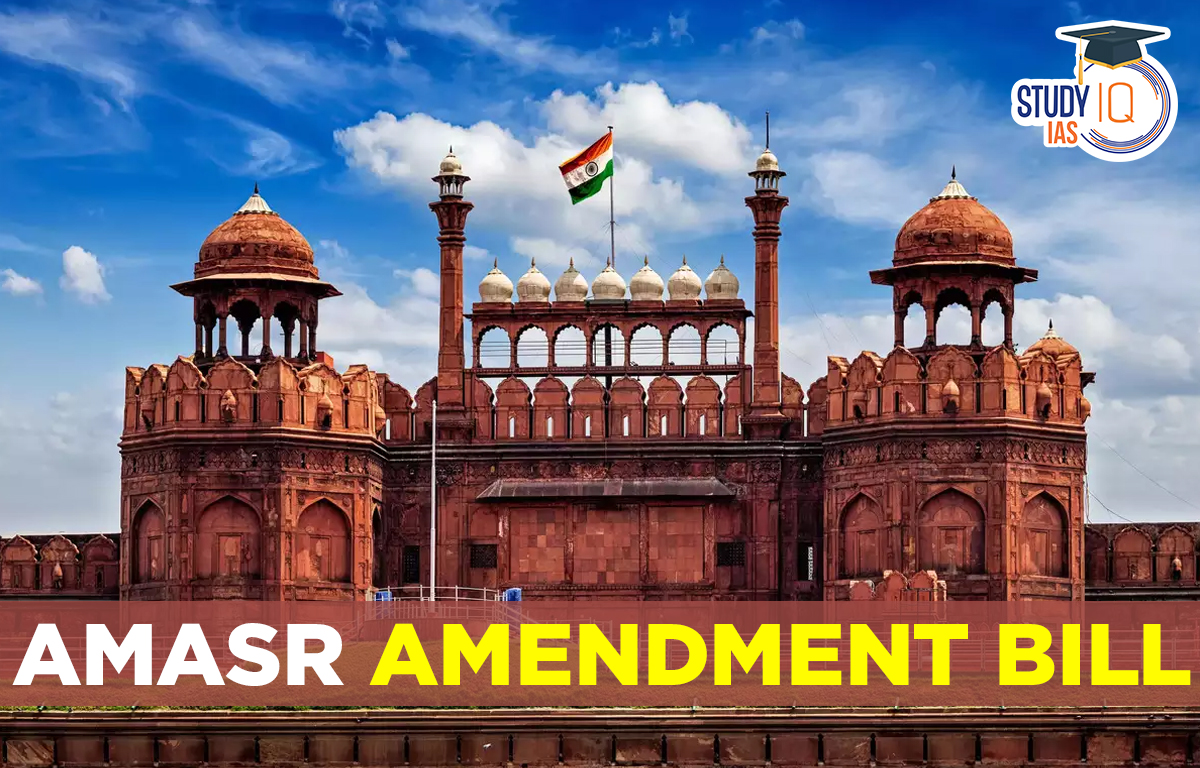Table of Contents
Context: The Union Government is expected to reintroduce the Ancient Monuments and Archaeological Sites and Remains (Amendment) Bill in the Parliament.
Ancient Monuments and Archaeological Sites and Remains (AMASR) Act
- AMASR Act: The AMASR Act was passed by the Parliament in 1958.
- The Archaeological Survey of India functions under the provisions of this Act.
- Purpose: It was passed for the purpose of protection and preservation of archaeological and historical monuments and sites.
- It also provides for the regulation of archaeological excavations and for protection of sculptures, carvings and other such objects.
- Definition of Ancient Monument: Ancient monument is defined as any structure, erection, or monument, or any tumulus or place of interment, or any cave, rock-sculpture, inscription, or monolith which is of historical, archaeological, or artistic interest and which has been in existence for not less than 100 years.
- Definition of Archaeological Sites and Remains: “Archaeological sites and remains” mean any area which contains or is reasonably believed to contain ruins or relics of historical or archaeological importance which have been in existence for not less than 100 years.
Archaeological Survey of India (ASI)
- The Archaeological Survey of India (ASI), under the Ministry of Culture, is the premier organization for the archaeological researches and protection of the cultural heritage of the nation.
- It also regulates Antiquities and Art Treasure Act, 1972.
AMASR Amendment Act 2010
- Purpose: The AMASR Act 1958, was amended in 2010 to strengthen its penal provisions, to prevent encroachments and illegal construction close to the monuments.
- Main Amendments:
- Prohibited area 100 metre around every national monument where no construction, public or private is permitted.
- Regulated area 200 metres beyond the prohibited area, where any construction requires permission of a newly constituted National Monuments Authority (NMA).
- NMA is under Ministry of Culture.
AMASR Amendment Bill 2017
- AMASR Amendment Bill: The AMASR Amendment Bill was first introduced in Lok Sabha on July 18, 2017.
- Changes in the Bill: Amendments in the Bill include:
- Construction in prohibited areas:
- The original Act prohibits construction in an area of 100 metres around protected monuments, and Union Government can extend this area beyond 100 metres.
- The Act does not permit construction in such prohibited areas, except under certain conditions. The Act also prohibits construction in ‘prohibited areas’ even if it is for public purposes.
- The Bill amends this provision to permit construction of public works in ‘prohibited areas’ for public purposes.
- Procedure for seeking permission for public works:
- For the construction (or reconstruction, repair, or renovation), the relevant Union Government department will be required to submit an application to the competent authority.
- The Union Government will determine whether the construction works in question qualify as public works, and the authority will then convey the decision of the Union Government to the applicant within ten days of the receipt of the decision.
- Definition of ‘public works’:
- The Bill introduces a definition for ‘public works’, which includes the construction of any infrastructure that is financed and carried out by the Union Government for public purposes.
- This infrastructure must be necessary for public safety and security and must be based on a specific instance of danger to public safety.
- Also, there should be no reasonable alternative to carrying out construction in the prohibited area.
- Impact assessment of proposed public works:
- The Bill empowers the National Monuments Authority to consider an impact assessment of the proposed public works in a prohibited area, including its archaeological impact; visual impact; and heritage impact.
- Construction in prohibited areas:

Significance of AMASR Amendment Bill
- More Power to ASI: The changes are expected to give more teeth to the Archaeological Survey of India (ASI) to remove encroachments from regulated zones around the monuments and hold the local authorities liable.
- The ASI would be given enforcement powers like in the Forest Act which would empower it to act against those encroaching at protested sites.
- Facilitate Infrastructure: The prohibition of new construction within prohibited areas of a protected area or protected monument is adversely affecting the various public works and developmental projects of the Union Government.
-
- With the Amendment, the government will be allowed to take up infrastructure projects for public works in this prohibited area.
-
- Ensure Standardization: Standardisation will be made for the inclusion of site/monument in ASI list and if need arises, monuments can also be dropped from the list.
- Less Burden on ASI: The list of ASI-protected monuments will be reviewed and some shall be removed from the ASI purview and pass on to the respective state archaeology departments for upkeep so that unnecessary burden can be shed off.
- The Review will also enable the ASI to take certain other monuments of ‘national importance’ under its wings.
- Expert Committees on Monuments: Proposed amendment would change Section 20A of the Act, which refers to the prohibited area, to rationalise the prohibited and regulated areas.
- Expert monument committees would decide the prohibited area around a particular monument.
- India Hosts G20: As India hosts G20 countries, some of the meetings will be held at important ASI sites also.
- So, it becomes imperative to look at areas around some of those sites and add required infrastructure for those high-profile meetings.
Concerns with AMASR Amendment Bill
- Add to Deterioration: The monuments which are already deteriorating due to pollution, permitting construction work around will further damage the foundations of centuries-old edifices.
- Deter Research: For research purposes, the earth around an archaeological site or ancient monument is very significant.
- If construction machines disturb it, then artefacts long buried in layers of soil risk being broken and their contexts destroyed. This makes the task of undertaking new research more difficult.
- Disturb Tourism: Public works by Union Government are executed more often than other small infrastructure projects which may even cause disturbance to tourism.
- Shatter Monuments: In recent years, the Government has built new highways, metro-rail systems, and industrial parks without methodical archaeological impact assessments.
- These projects have led to the shattering of an untold number of historical artefacts.
- Ambiguous Definition: According to the Select Committee, the definition of public works specified in the Amendment does not cover public utility projects (like Metro construction) that do not specifically fall under “safety and security”.


 Future of Governance in Post-Maoist Indi...
Future of Governance in Post-Maoist Indi...
 Sabka Bima Sabki Raksha Amendment Bill 2...
Sabka Bima Sabki Raksha Amendment Bill 2...
 MP Police Answer Key 2025 Out at esb.mp....
MP Police Answer Key 2025 Out at esb.mp....

























